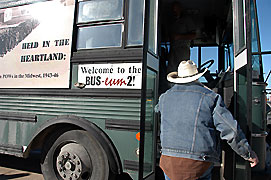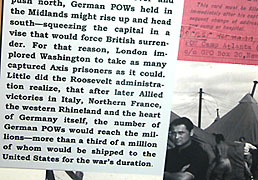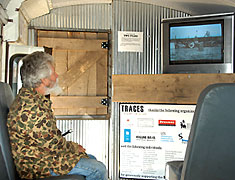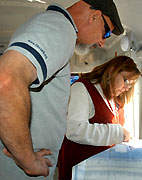
Hardly anybody may remember this. That's why TRACES, a BUS-eum was parked across the street from the Neosho-Newton County Library recently to brush away the cobwebs and unearth the relationship developed between local Midwesterners and those with whom the US had been at war.
Thanks to the efforts of an organization from St. Paul, MN, the exhibit in a 40-foot converted school bus tells the story, "Held in the Heartland - German POWs in the Midwest, 1943-46." The "mobile classroom" consisting of 15 narrative display panels illustrated with photographs and documents was created to humanize the "enemy" by describing life in the camps.

History revealed that when Erwin Rommel's troops surrendered to British and American forces in Tunisia in May 1943 more than 100,000 became prisoners, an overwhelming number. The Us government appropriated ocean liners such as the Queen Mary to transport 15,000 PWs at a time. The boats landed at Newport News, New York or Boston and the prisoners were then transferred to Pullman train cars bound for the Midwest.
Many while on Pullman cars saw black people for the first time, Irving Kellman, the bus driver/exhibit guide said. And many for the first time, he said, ate meals on paper plates that they were told to throw out of the train windows.

Two film clips continuously were being shown in the rear of the bus. One showed how local farmers at first frightened by the PWs changed their attitude after they realized how the PWs could help them generate money by saving their crops. These PWs, accompanied by a guard, were allowed to leave the camps to work the farms.
The farmers paid the US government 40-cents an hour for each PW laborer. Kellman explained how the US government made $40 million by in turn paying the German prisoners 10-cents an hour.
It should be noted that due to a labor shortage the PWs at Crowder worked at the camp itself performing necessary services like doing the laundry, Kellman said. And they were paid in camp script instead of money for obvious reasons.

Ginny Ray, director of the Neosho Newton County Library points out the location of Camp Crowder on a map to TRACES bus driver/exhibit guide Irving Kellman.
One of the stories Kellman related had to do with a prison escape. He said that in trying to reach Mexico some prisoners from a camp in Arizona got lost. They were captured near Baja California after not being able to find a river that they had hoped to float on to reach their destination. The escapees wanted to know who had the audacity to put a dry river on a map, Kellman said.
One of the panels described how foiled escapees faced solitary confinement or bread and water diets for repeat offenses. The same panel mentioned how several thousand Volga Deutsche --Soviet citizens of German descent that allegedly were forced to fight--were turned over by the US to Soviet officials and promptly shot. It also said that special camp branches had to be set up to separate those still embracing Nazism from those who no longer believed in it.
The film also discussed life in the Algona Camp in Iowa. With the belief that keeping prisoners busy kept order in the camps, camp officials encouraged hobbies. Many prisoners showed their musical expertise, others their artistic sensibilities. Broom handles, for instance weren't safe, as they could be carved into chess pieces.
One prisoner named Eduard Kaib left a legacy of a nativity scene that he carved on a half-life-size scale. The nativity scene remains a tourist attraction in Algona; much of the art that was created may be found in the Muscatine Art Center in Iowa where it was gathered by the curator to reflect the social consequences of war.
When asked whether the prisoners were allowed to remain in the US after peace was declared, Kellman said that, no, they had to return to their homeland where they had to stay for three years before applying to re-enter the US. And many wanted to return.
The exhibit showed how wars might leave deep lasting scars. However, when participation in war is understood and prisoners are treated with courtesy, then lasting friendships instead of continuing hatred ensue.
The bus is supported in part by the Firestone Company, Hoglund Bus Company, the Minnesota Humanities Council and many, many individuals.
A permanent exhibit on the subject of German-American Internment, 1941-48 provided by the TRACES Center for History and Culture may be found at the Landmark Center, 75 W. Fifth St., Suite 211, St. Paul, MN. For more information about TRACES, go here.






Comments